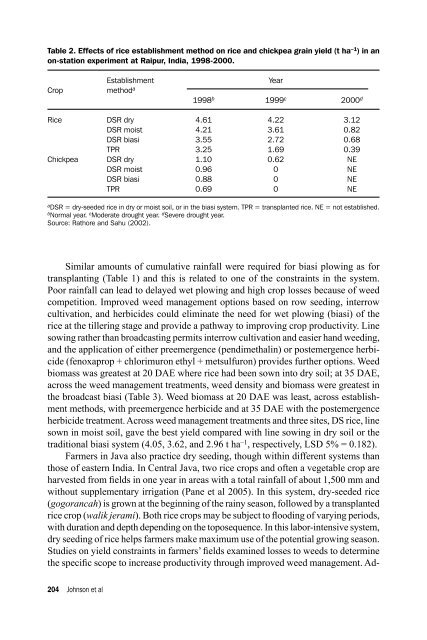Download (2461kB) - University of Greenwich
Download (2461kB) - University of Greenwich
Download (2461kB) - University of Greenwich
- No tags were found...
Create successful ePaper yourself
Turn your PDF publications into a flip-book with our unique Google optimized e-Paper software.
Table 2. Effects <strong>of</strong> rice establishment method on rice and chickpea grain yield (t ha –1 ) in anon-station experiment at Raipur, India, 1998-2000.EstablishmentYearCrop method a 1998 b 1999 c 2000 dRice DSR dry 4.61 4.22 3.12DSR moist 4.21 3.61 0.82DSR biasi 3.55 2.72 0.68TPR 3.25 1.69 0.39Chickpea DSR dry 1.10 0.62 NEDSR moist 0.96 0 NEDSR biasi 0.88 0 NETPR 0.69 0 NEa DSR = dry-seeded rice in dry or moist soil, or in the biasi system. TPR = transplanted rice. NE = not established.b Normal year. c Moderate drought year. d Severe drought year.Source: Rathore and Sahu (2002).Similar amounts <strong>of</strong> cumulative rainfall were required for biasi plowing as fortransplanting (Table 1) and this is related to one <strong>of</strong> the constraints in the system.Poor rainfall can lead to delayed wet plowing and high crop losses because <strong>of</strong> weedcompetition. Improved weed management options based on row seeding, interrowcultivation, and herbicides could eliminate the need for wet plowing (biasi) <strong>of</strong> therice at the tillering stage and provide a pathway to improving crop productivity. Linesowing rather than broadcasting permits interrow cultivation and easier hand weeding,and the application <strong>of</strong> either preemergence (pendimethalin) or postemergence herbicide(fenoxaprop + chlorimuron ethyl + metsulfuron) provides further options. Weedbiomass was greatest at 20 DAE where rice had been sown into dry soil; at 35 DAE,across the weed management treatments, weed density and biomass were greatest inthe broadcast biasi (Table 3). Weed biomass at 20 DAE was least, across establishmentmethods, with preemergence herbicide and at 35 DAE with the postemergenceherbicide treatment. Across weed management treatments and three sites, DS rice, linesown in moist soil, gave the best yield compared with line sowing in dry soil or thetraditional biasi system (4.05, 3.62, and 2.96 t ha –1 , respectively, LSD 5% = 0.182).Farmers in Java also practice dry seeding, though within different systems thanthose <strong>of</strong> eastern India. In Central Java, two rice crops and <strong>of</strong>ten a vegetable crop areharvested from fields in one year in areas with a total rainfall <strong>of</strong> about 1,500 mm andwithout supplementary irrigation (Pane et al 2005). In this system, dry-seeded rice(gogorancah) is grown at the beginning <strong>of</strong> the rainy season, followed by a transplantedrice crop (walik jerami). Both rice crops may be subject to flooding <strong>of</strong> varying periods,with duration and depth depending on the toposequence. In this labor-intensive system,dry seeding <strong>of</strong> rice helps farmers make maximum use <strong>of</strong> the potential growing season.Studies on yield constraints in farmers’ fields examined losses to weeds to determinethe specific scope to increase productivity through improved weed management. Ad-204 Johnson et al
















